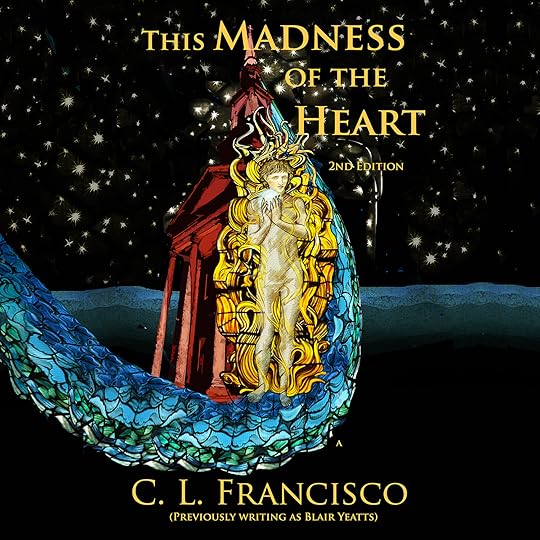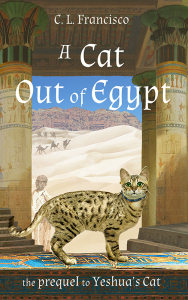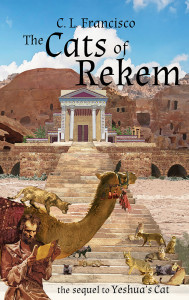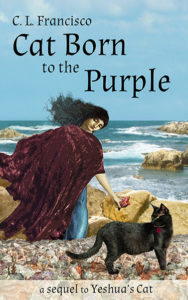C.L. Francisco's Blog, page 4
January 19, 2017
“This Madness of the Heart” Due in February!
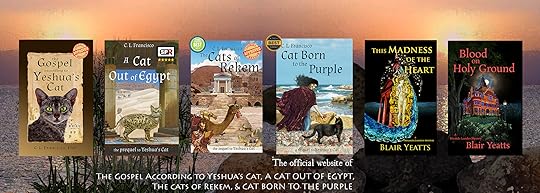
The second edition of the new gothic mystery This Madness of the Heart is almost ready for release!
I’ve made substantial edits to the book’s content, in addition to the more conspicuous change in authorship. In case you’re just joining us for the first time, Madness was first released in 2016 under C. L. Francisco’s pen name, Blair Yeatts. If you’re curious about the reasons for this change in authorship, take a look at my previous blog entry, dated January 5th.
The Miranda Lamden Mysteries are gothic mystery-thrillers exploring the many disasters human beings can bring down on their own heads. Fortunately for the books’ characters, Professor Miranda Lamden is there like a forensic religionist to make sense of the shattered pieces of the many strange belief systems she encounters, and bring some healing to those caught up in the chaos.
I plan to release the Kindle version on February 10th. The paperback will be available later in the month.
For more details, visit Blair Yeatts’ blog.
Mark your calendars now!
Save
Save
January 5, 2017
Bringing C. L. Francisco and Blair Yeatts Together

Bringing C. L. Francisco and Blair Yeatts Together
 I imagine two women walking a little apart in an autumn wood where filtered sunlight hangs in the air like rainbows cast by stained glass windows. They might be sisters, although separated by many years: one has dark hair with ruddy highlights, while the elder’s hair shines silver in the shifting light. Both are tall, with the easy gait of serious walkers, loose denim skirts swirling around their legs as they stroll. Each gazes at the wood intently, reaching out to touch the trees . . . a beech here, an oak there . . . eyes shining with pleasure. The same surety of a benevolent Creator’s love undergirds both, rising up through the fallen leaves like an unfailing spring. But there they part ways.
I imagine two women walking a little apart in an autumn wood where filtered sunlight hangs in the air like rainbows cast by stained glass windows. They might be sisters, although separated by many years: one has dark hair with ruddy highlights, while the elder’s hair shines silver in the shifting light. Both are tall, with the easy gait of serious walkers, loose denim skirts swirling around their legs as they stroll. Each gazes at the wood intently, reaching out to touch the trees . . . a beech here, an oak there . . . eyes shining with pleasure. The same surety of a benevolent Creator’s love undergirds both, rising up through the fallen leaves like an unfailing spring. But there they part ways.
The younger woman knows herself wounded and angry, torn from her roots, unable and unwilling to return to them. Life for her is a trackless horizon, where she must make her own way among a maze of confusing choices,
. . . a life rent by the emptiness of years alone, of stubborn search and dead-end roads, a renegade among the certain, a voiceless stranger in the garrulous crowds.

The older woman has made her peace with that old pain, accepted the paradoxes, and learned compassion for herself and the ghosts of her past. Her eyes dwell on the infinity of light surrounding her. She falls back into shadow only rarely, and when she does, she knows the light holds her still.
Yeshua’s Cats speak with the voice of the older woman. The Miranda Lamden Mysteries live in the younger woman’s world, overlaid with the hindsight of the elder. But they are both the creation of a single heart. I hope this post may help you bring them together. I’ll also say that, with the exception of a few creative details necessary to establishing a pen name, all Blair Yeatts’ memories and thoughts shared in posted interviews are C. L. Francisco’s own, although offered from the perspective of that younger self.
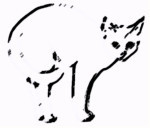
Blair Yeatts’ This Madness of the Heart was my first book, apart from a mammoth PhD dissertation and an unpublished memoir. I finished the original draft almost 20 years ago, as a way of venting my hurt and anger at the dirty tricks and character assassinations in the fundamentalist takeover of a conservative protestant denomination. As often happens in revolutions, a zealous minority overwhelmed a more moderate and less vocal majority, and then ruthlessly silenced those who disagreed with them. This previously loose-knit denomination had a cherished history of settling doctrinal disagreements locally: churches had simply split, becoming the 1st, 2nd, etc., churches in a given town. Dissent was in their blood, like the freedom of the individual believer. But this ultra-conservative minority targeted the whole assembly of churches in an iron-fisted power grab.
Once the coup was accomplished, dissidents had two choices: either bow to the doctrines of the new power elite, or leave the church. The denomination of my youth was swept away in a furor of self-righteous certainty. Pastors, professors, and church leaders were driven out. Hearts and lives were broken. Doctrine was narrowed, warped, and set in stone. Callings scorned and contracts withdrawn, women clergy left to find ways to minister among people with a wider view of God’s mercy. A few powerful men now controlled the hearts and minds of the denomination’s mostly oblivious members. There was nothing I could do . . . so I wrote a book.

Unfortunately, trying to read Madness’ original draft felt much like Harry Potter opening the screaming book in the Hogwarts’ library: the anger I’d poured into it flamed from its pages. I realized this at the time, and set it aside—for almost twenty years—until I could return and treat it as a mere story. Then I wrote most of the anger out, leaving a fast-paced tale about a slimy charlatan with an honorary divinity degree in a haunted hollow in Appalachia. The story is admittedly over the top . . . vengeful ghosts don’t play feature roles in most grifters’ lives. But where evil thrives, its deadliest mass tends to hide beneath the surface . . . often masquerading as holiness.
I found myself alienated from the Christian faith during two periods in my life: first for the decade spanning college and my early twenties; second, beginning with the fundamentalist takeover and stretching across another 10-15 years. I still find myself at odds with much of the organized Church. I wrote The Gospel According to Yeshua’s Cat as an expression of my own faith in a Jesus of Nazareth who speaks with love and compassion, untouched by the legalism he challenged. A cat’s voice seemed appropriate for the task. The first book has now multiplied into four, with a fifth on the way.
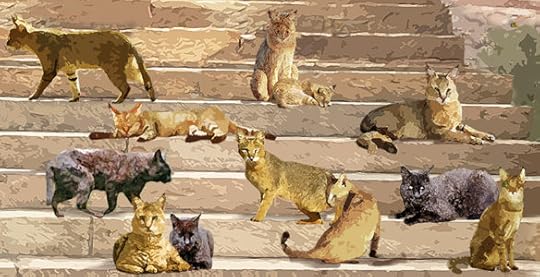
The Miranda Lamden Mysteries have roots in those secular years, as well as in my lifelong love of mysteries, starting with Nancy Drew and most recently Charles Todd. They are not Christian mysteries. Neither are they “cozies” (emerging from a cozy mystery feels to me like struggling out of wad of cotton batting back into the realities of life). Ugly or not, if a thing is part of human experience, it’s fit to write, and read, about. Violence is part of life, and so are pain and tragedy; they belong in novels, and you will find moderate amounts in mine. But I also write about what I call “spirit” or “faith” or “redemption”—pick whichever word you like: without it the unremitting darkness of despair grinds human beings into something subhuman.
I write mysteries I’d like to read: novels of danger and intrigue, with depths of love and pain, where characters wrestle with despair and disaster, and fight their way through to the light. They surmount capricious hazards without toxic overloads of violence or sex. Spirituality and questions of meaning drive both cast and plot. I don’t strive for great literature, but for a read an intelligent mystery-lover would welcome at the end of a long day—and have difficulty putting down. I don’t guarantee happy endings, but I never end a book with despair and shattering loss of meaning . . . endings may be bittersweet, but they’re always suffused with hope.

If you’re a Blair Yeatts reader, would you like Yeshua’s Cats? If you’re a Yeshua’s Cats reader, would you like the Miranda Lamden Mysteries? Here’s my take.
Yeshua’s Cats are intended for a Christian audience, although reviewers have repeatedly assured readers that their appeal is much broader. The two most recent books, The Cats of Rekem, and Cat Born to the Purple, have both been chosen for Indie Reader’s “Best of” new book list for 2015 and 2016 respectively. But if you’re a devout atheist, or not at all spiritually inclined, I suspect you wouldn’t like them. If you’re a cat-lover you might leap all other boundaries and enjoy them anyway.
The Miranda Lamden Mysteries are full of spiritual matters of one sort and another, since Miranda is a professor of religion and an expert on paranormal phenomena . . . they’re for spiritually curious readers. But if you’re a conservative Christian who thinks preachers can do no wrong, you won’t like the first book. If you believe that you’re in possession of the only truth, and don’t care to consider anyone else’s perspective, you won’t like any of the books in the series. Like Miranda, I’ve spent much of my life in institutions of higher learning, and I’ve seen too many people convinced of the unassailable rightness of their own opinions, mistaking the echoes of their own thoughts for the voice of God. That way lies the Inquisition.

Goya, “Scene from the Inquisition”
So why did I reverse direction and decide to claim these mysteries as my own? I think the presidential election made my choice for me: the tragedy of my denomination is now replaying on the national stage, and my mysteries have become appallingly relevant. In Miranda’s words, from This Madness of the Heart:
How had we stood by and let such a man amass so much power? Why were the good people of the town not fleeing the contamination of his spirit? How could they not sense the heart of hate beneath his harangues? Any amount of violence might erupt from the bloodlust JJ was whipping up among God’s elect. Religion! Why did the search for ultimate love so often end in hate?
“What does the Lord require of you, but to do justice, and to love kindness, and to walk humbly with your God?” (Micah 6:8)
I realize that choosing a side in a divisive political—and religious—controversy may alienate me from some of my readers. I hope not. But for me this has become a matter of conscience, and keeping faith with myself . . . as well as with my faith.
Freedom of conscience has always been our privilege in America, but it didn’t come free: it was bought with the lives of people desperate for liberty, and its defense lies in our hands today. I pray we will have the strength and integrity to preserve the freedom our founders entrusted to us.

December 26, 2016
A Blessed Christmas and Holiday Season!

Caspar David Friedrich, “Winter Landscape with Church”
A few words from Elizabeth Goudge–for the season, and in hope for the future:
“Everything the One touches is changed, death to life, emptiness to liberty–
and not only changed, but changed into the One’s own self,
since the One himself is reversal . . .
loss turned to restoration, and decay to renewal.”
November 28, 2016
How Cat Born to the Purple Began

Readers are always asking me how I get the ideas for my books, and I’m usually at a loss for answers. So with Cat Born to the Purple, I tried to notice right along how the ideas developed. Now I offer you a small window into the earliest beginnings of Purple.
When I introduced Purple’s main character, Eliana, in The Gospel According to Yeshua’s Cat, I hadn’t planned on writing anything else about her, much less a continuing series of Yeshua’s Cats books! But I did write more books, and Eliana turned out to be one of those characters who set up shop in the back of my mind, insistently hammering at my dreams and thoughts until I allowed her to tell her story: Cat Born to the Purple is her tale.
But before I could tell her story, I had to figure out what her family history might have been, and what circumstances could possibly have left her, a young woman barely more than a child, stoned and near death in the hills of Galilee near Sepphoris. I knew that she was going to be an exceptionally fine weaver and embroiderer, which meant that she probably came from a family that worked with textiles, most likely from one of the semi-professional family workshops found in sizeable towns like Sepphoris.
But her wrongful stoning suggested that she’d had no real family to protect her. How could that have happened? Jewish women of merchant status always had male relatives from their birth-families hovering in the background somewhere, prepared to protect them from abuse. I started reading everything I could find about the area around Sepphoris during the time of Herod the Great and his son Herod Antipas, since Eliana would have been born around 12 CE.

Herod the Great’s port at Caesarea Maritima, 10 BCE
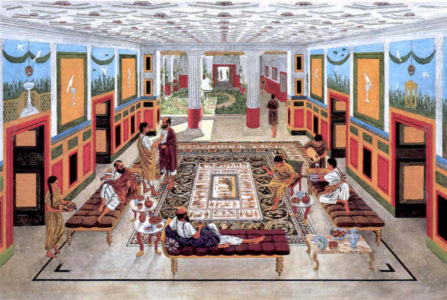
Reconstruction of Sepphoris Dionysos mansion
Scholars have been wrangling for years over whether the Sepphoris of Yeshua’s youth and adult years was primarily Jewish, Greco-Roman, or a mixture of the two. The dust is finally beginning to settle in that argument, leaving what seems to be a clear picture of Sepphoris—along with most of the rest of the Galilee—as predominantly Jewish in population and culture during the early-to-middle 1st C CE. The recently discovered Greco-Roman palaces of Sepphoris came considerably later.
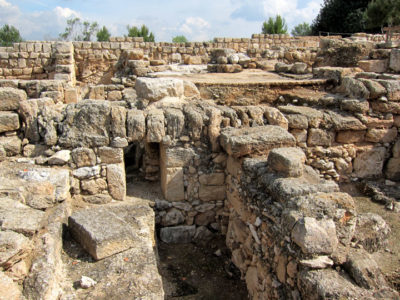
Remains of early 1st C Sepphoris
Almost nothing remains of the mid-1st C city, which would have been almost entirely Jewish. During Yeshua’s lifetime Sepphoris was a regional market and civic center—Herod Antipas’ Galilean capital until he built a new capital at Tiberius around 20 CE. Sepphoris was a large Jewish town for its time and place, but neither Roman in culture, nor heavily gentile.
The most dramatic event in Sepphoris’ history during that early period came soon after Herod the Great’s death in 4 BCE, when a band of Jewish dissidents and townspeople overwhelmed the city guard and raided the treasury. Rome’s reprisal was swift and cruel. The rebels were crucified along the highways, and most of Sepphoris’ citizens were sold into slavery at Acco. Herod Antipas rebuilt and fortified the city to some extent before moving on to Tiberius, but he didn’t create the wealthy Greco-Roman Sepphoris whose ruins have been excavated in recent years.
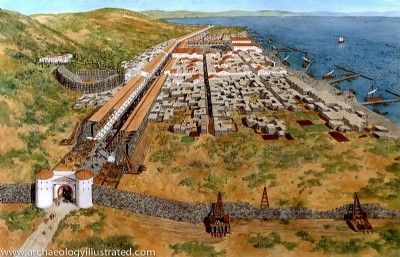
Artist’s Reconstruction of Tiberius
So with this regional history in mind, Eliana’s own family history began to fall into place for me. The timing of Eliana’s birth could easily have placed her grandparents in Sepphoris as weavers and merchants when the city’s residents were sold into slavery by the Romans in 4 BCE. Only their young daughter Sarah—Eliana’s mother—perhaps eight years old at the time, managed to escape. Terrified and confused, the homeless child was taken in by a kindly woman from Shikhin, a neighboring village of about 500 people. Archaeologists recently discovered the ruins of Shikhin only a mile northwest of Sepphoris, just off the main highway connecting Acco and Sepphoris. The Via Maris, the major Roman road that followed Israel’s coastal plain along the Mediterranean Sea, intersected the Acco-Sepphoris road nearby, placing both Sepphoris and Shikhin at a major crossroads.
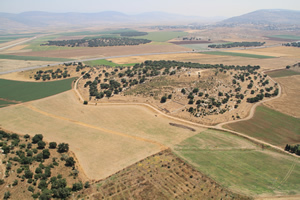
The low hills of Shikhin
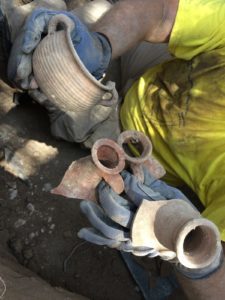
Shikhin pottery fragments
Archaeologists had long searched for the location of Shikhin, known by reputation as a village that manufactured everyday pottery found in archaeological sites all across Israel. Rabbis of the early Roman period even used Shikhin storage jars as their standard for liquid measure. Shikhin’s period of greatest productivity probably began sometime in the late 1st C BCE and increased through the early Roman period. They were known for strong, fire resistant pottery made from black clay: particularly amphorae (storage jars) and small clay lamps, but also jugs, kraters, cooking pots, and bowls. Archaeologists guess that Shikhin’s potters may have made common cause with wine and oil merchants and sold their pots already filled.
Recent excavations at Shikhin have uncovered cisterns, pits, potters’ wheels, kilns, and large numbers of discarded pieces of pottery damaged in firing, indicating a significant manufacturing area. The site was abandoned around the time of the great earthquake of 363 CE.

Shikhin amphora, potsherds, lamps, potter’s wheel fragment, juglet
Now the story was beginning to take shape in my mind. As a refugee child in a time of chaos, Sarah’s unofficial adoption by a family working at a craft totally unlike her family’s own guaranteed her separation from any extended family who might have survived the upheavals at Sepphoris. She was simply a child working beside her adopted family making pots. Sarah eventually married the potters’ only son and taught her daughter Eliana the skills of a potter. But even though Sarah had lost her parents at a young age, I imagined that she would never have forgotten the weaving and embroidery skills she must have learned at her mother’s knee–which would probably have been valued by her adopted family. These skills she passed on to Eliana as well, along with an innate gift for working with textiles.
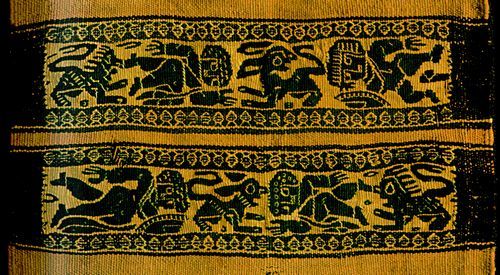
Sleeveband from 3rd C CE Mediterranean textile
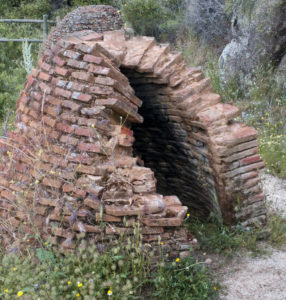
Old brick kilns in Spain
But for Eliana to be without family when Yeshua found her, both her parents must have been dead already. After learning what I could about the manufacture of ancient Palestinian pottery, I decided that her parents might have died together in a fire caused by a collapsing kiln during a minor earthquake (more on that in another post). So Eliana was indeed left alone in the world, a young bride without anyone but treacherous and greedy in-laws to care for her. The complex system of Jewish kin relationships protecting vulnerable women had failed her. Yeshua’s assumption of just such a situation led him to place Eliana with his friend Eli in Cana—which is where Cat Born to the Purple truly begins.
In the end, the unique possibilities presented by 1st C Israel’s culture came together to create the backstory of Eliana’s life, thus laying the groundwork for the rest of the book. Research can be a wonderful thing!
November 21, 2016
A Christmas Prayer for 2016
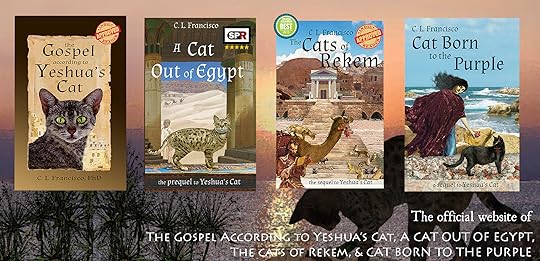
I’ve been on an extended retreat for the last week or so, grieving and praying over the inhumanity I see steadily emerging in the patterns of our new American administration. I know good, well-meaning people voted for our new incumbent–many friends of mine did–but I fear they will be shocked by the reality that is taking shape. May we all pray for America, and for a world we cannot and should not shut out.
I don’t understand how so many of America’s Christians have gotten so muddled. What has happened to “For God so loved the world that he gave his only Son”?
Or “There is neither Jew nor Greek, slave nor free, male nor female”?
Or “Let justice roll down like waters and righteousness like an ever-flowing stream”?
Or “What does the Lord require of you but to do do justice, to love kindness, and to walk humbly with your God?”

“The Scapegoat,” by Wm Holman Hunt
We have stumbled and fallen at the 3rd temptation where Yeshua stood firm: we have grasped for power. Yeshua’s words in this passage from Yeshua’s Cat describing his final temptation in the wilderness speak for me:
There was silence for a time. Then ben Adamah’s eyes cleared, he saw me watching, and he smiled. Now he was looking at a definite place, somewhere to the right of where I stood (my fur was bristling, and I was ready to spring away at any moment. Did I see something moving there in the moonless dark?).
“Oh, you evil fool,” the son of Earth laughed, “you have misjudged your game tonight! I have seen too many good men corrupted by even a little of that power to fall into its snare. The power I seek is the power to heal body and soul, the power of one who walks unnoticed among many, seeking the good of all: the power that binds creation together, not a power that consumes it. Burning through my heart is a power that rejects you and all you offer. I will have none of your thrones, your palaces, or your rich robes. No man, woman, or child will ever grovel before me in fear! Get out of my sight, corrupter of innocence. You have no place here.”
The night grew quiet then, the tension vanishing on a slight breeze. Whatever had been happening was finished.
“Come, curl up beside me, little mother,” ben Adamah said softly. “My vigil is over for tonight. It’s time to sleep.”

Part of my prayer this week has been a visual prayer. When I want to focus my prayer over time and across all my senses I do art as a prayer–both in process and its final emergence into the world. Here is this week’s result: “A Christmas Prayer”: that the incomprehensible divine love we celebrate at the Christmas season may fill all our hearts, and open our eyes to the wideness of God’s mercy, encompassing the whole of Creation.
[image error]
A Christmas Prayer in 2016, C.L. Francisco
For those of you with a curious turn of mind, I’ll explain a bit of what’s going on in this digital mosaic. The overall pattern is based on the south rose window at Notre Dame of Paris. Literally thousands of digital layers were combined to complete the whole.
At the very center is a spiral galaxy from the Hubble series, with a star superimposed, also from Hubble, and a close up of Mary and the baby Jesus from William Holman Hunt’s “The Triumph of the Innocents.”
Around the central image is a circle of 12 identical panels of the “Tree of Jesse” from Chartres Cathedral.
The round rose-window shapes in the next ring are 24 identical images of grape leaves from another Notre Dame rose window, pieced together into rings.
The next circle out from the center is composed elders from traditions all over the world, including Pope Francis, an Orthodox bishop, Rev. Desmond Tutu, the Dalai Lama, and many others from cultures great and small.
Behind each elder’s head is a plain aquamarine stained glass circle.
Above these circles are hands of different colors, each reaching out to help the others and to the One in prayer.
Beyond the ring of hands are round stained glass windows with the faces of ordinary people from ethnic groups around the world.
Interspersed between these portrait circles are small stained glass windows from Notre Dame de la Croix.
Around the outer edge of the circle are flowers from blossoming trees holding the faces of the world’s children, overlain with translucent spring beech leaves.
From behind each blossom the Bethlehem star shines out.
Throughout the whole circle the branches of the tree of life weave in and out of the pattern.
And overall, a rainbow of stained-glass light colors all the shapes beneath it, just as the One’s love embraces all Creation.
I wish you all a blessed Thanksgiving and Christmas, filled with gratitude for our many blessings, and with prayers for our leaders’ wisdom.
November 10, 2016
Each Yeshua’s Cats e-book only $.99 tomorrow!
ALL 4 Yeshua’s Cats e-books will be discounted
with Amazon’s Kindle Countdown
November 11th – 14th,
to celebrate the publication of Cat Born to the Purple!
Here’s how the Kindle Countdown works:
Starting at 8 AM PST (that’s 11 AM EST) on Friday, November 11th, each of the 4 Yeshua’s Cats e-books will be available for sale on Amazon for only $.99 — for 24 hours only.
Then, starting at 8 AM PST (11 AM EST) on Saturday, November 12th, each of the 4 Yeshua’s Cats e-books will be available for sale on Amazon for only $1.99 — again, for 24 hours only.
Then, starting at 8 AM PST (11 AM EST) on Sunday, November 13th, each of the 4 Yeshua’s Cats e-books will be available for sale on Amazon for only $2.99 (half-price) — again, for 24 hours only.
The $2.99 discount ends at 8 AM PST (11 AM EST) on Monday, November 14th, and the regular price resumes.
Don’t let this chance slip away!
It will be at least 6 months
before Yeshua’s Cats will be discounted again!
Click on the book (or books) of your choice to go to the book’s Amazon page on one of the discount days:
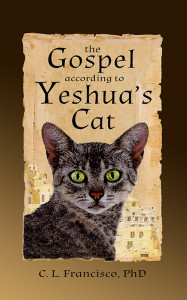 The Gospel According to Yeshua’s Cat:
The Gospel According to Yeshua’s Cat:
A Cat Out of Egypt:
.
November 7, 2016
Royal Purple Murex Dye

Before discussing the Murex dye, I’m delighted to announce the 3rd of the 3 reviews received for Cat Born to the Purple: another 5 stars ★★★★★ — this time from Self-Publishing Review! Go here to read the entire review.
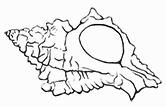
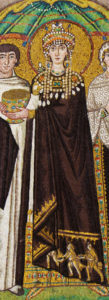
Empress Theodora in royal purple, 6th C
The term “royal purple” originated in the Mediterranean and Ancient Near East, particularly during the days of the Roman Empire, when the wearing of a specific color–royal purple–was a privilege restricted to the aristocracy, if not the emperor alone. Royal purple was not the color we think of today when we speak of purple. Apparently it was an almost black violet-red color, said to resemble the color of heart’s blood/clots of heart’s blood. The word “purple” in Greco-Roman times, however, was used to refer to a whole range of colors, from pale blue to red to violet to the true royal purple. Deciding which of these many colors was intended in a given passage can be difficult.
But historians agree that the priceless near-black “royal purple” dye was made only from a gland of the Murex trunculus (more recently called Hexaplex trunculus) sea snail. Depending on the strength of the dye, the time submerged, the dye process, and the type of fabric dyed, the Murex dye could also yield colors ranging from pale shades of blue, green, pink, and violet, as well as the deeper tones. Other varieties of the Murex, particularly brandaris, were also used for dyes, but were considered inferior.
At present a whole separate debate is ongoing among Jewish traditionalists about whether the blue (tekhelet) tassels required by the Torah on the corners of Jewish garments should be dyed using Murex trunculus. Recent archaeological discoveries of fabric remnants from Israel’s biblical period indicate that the original tekhelet dye was probably made from one of the Murex family, if not the trunculus, but since the source of the original tekhelet has been uncertain for so long, white has become the preferred color for these tassels. Ruscillo’s research (see below) found that immersing wool very briefly in a fresh, unheated Murex dye bath resulted in very attractive blues of varying intensity.

Tekhelet?
The Murex trunculus sea snail lives in the sublittoral waters of most of the Mediterranean’s coastal areas. The sublittoral zone refers to the area of relatively shallow water permanently covered by seawater that is immediately beyond the intertidal zone (the area between the high and low tidal marks, where the shore is above water at some point in the tidal cycle). The Murex must be constantly submerged to survive, but it prefers shallow water, usually no more than 20 meters deep, in sheltered coves or lagoons. Where the water is calm and protected from waves the Murex may be found at slightly greater depths. It prefers mixed sand and rocky bottoms.

Sublittoral ocean zone
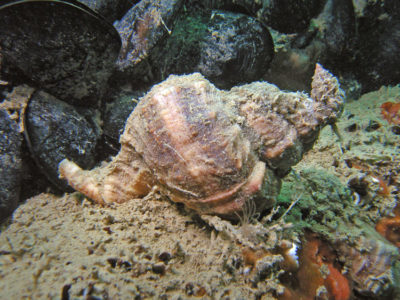 The Murex feeds in two different ways: scavenging and predation. When there isn’t enough dead material in the water, it preys on other sea snails, mussels, barnacles, hermit crabs, etc., by drilling holes and/or chipping their shells and feeding on the living flesh through the holes. Not an appealing creature, as predators go.
The Murex feeds in two different ways: scavenging and predation. When there isn’t enough dead material in the water, it preys on other sea snails, mussels, barnacles, hermit crabs, etc., by drilling holes and/or chipping their shells and feeding on the living flesh through the holes. Not an appealing creature, as predators go.

Murex spawning
The ancients didn’t dive for the purple snails during the months between early spring and the beginning of July, because that was (and is) the Murex spawning season. Murex trunculus was harvested from the Dog Star’s first rising in the dawn sky (early July) through the winter months.
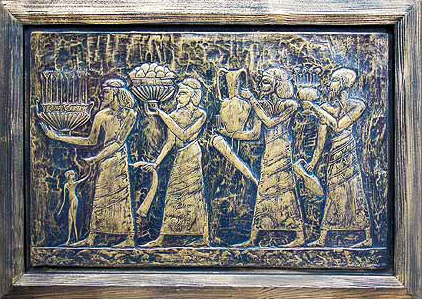
Phoenician merchants
Since the only records we have describing the collecting and processing of “purples” are the writings of Roman essayists like Pliny and Vitruvius (whose reports were often more imaginative than accurate), archaeologists have had difficulty piecing together the details of the royal purple industry. Additionally, the Phoenicians–whose Murex dyes were most highly valued in early Roman times–guarded their dyeing secrets carefully. Only in the early 20th century did scientists begin to experiment with Hexaplex trunculus to try to reproduce the ancient dyeing techniques.

Artist’s Reconstruction of Tyre before Alexander’s conquest
Deborah Ruscillo’s experiment, “Reconstructing Murex Royal Purple and Biblical Blue in the Aegean,” is by far the cleverest, and most innovative approach to this problem that I could find. By grossly simplifying her methodology, I might summarize it like this: locate an ancient Murex dyeing site where the Hexaplex trunculus is still thriving, and duplicate the processes suggested by archeological evidence and ancient texts, using tools as close to the originals as possible; where ancient wisdom fails, experiment with reasonable alternatives.
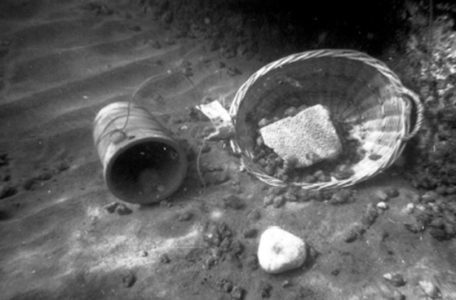
Ruscillo’s baited pot & basket
Most of Cat Born to the Purple‘s technical details of Murex dyeing came from Ruscillo’s work. For instance:
Neither divers nor baited baskets/pots alone could have caught enough purples to supply a dyeing workshop of any size; they must have both been used together.
Adding urine makes the color more vibrant, although the Murex dye is permanent without additives
Boiling the dye mixture ruins the dye
Three days is the ideal amount of time for steeping fabric in the dye
The stench of the Murex, swarming wasps, biting flies, and hatching larvae make the dyers’ lives a misery
Dye on hands and nails takes roughly 6 weeks to disappear
Wool is the only fiber that absorbs the dye to create a deep, dark color
Neither the stink nor the color is reduced by washing; perfume would have been necessary to disguise the smell, even after washing and long periods of airing.
Perhaps her most amusing and understated remark was, “Pliny never made dye himself.”
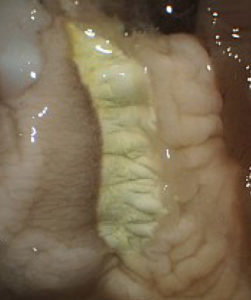
photo Kirsten Benkendorff
The dye comes from the hypobranchial gland of the Hexaplex trunculus, which secretes mucus for its mantle. The gland itself is pale, and must be cut out of a living snail (left), since the gland shrivels and dries shortly after death.
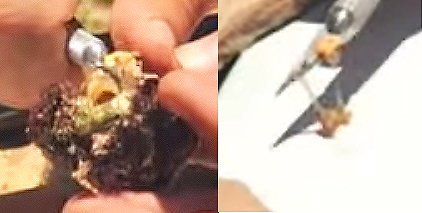
photo by kuvmamhlubhmoo
When the live gland is pierced and exposed to air, the mucus rapidly changes from clear to yellow to yellowish green, green, and violet. The photos to the right show a fresh live trunculus gland removed. The gland itself is yellowish, but the liquid is clear.
The photos below show a sequence from Pourpre filmed by pygmeejones. The timing and color may not be exact, since the snail in the sequence appears to be recently dead or the gland already ruptured in opening the shell, based on the green color of the mucus when the gland is first pierced.
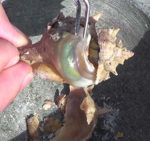
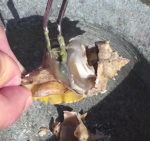
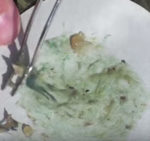
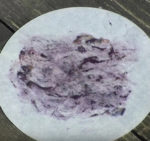
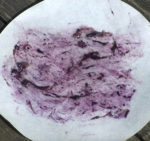
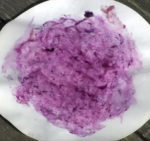
Archaeologists have discovered what appear to be holding tanks for snails along the Phoenician coast, where Murex could have been kept alive in seawater until enough snails had accumulated to brew the dye. Since thousands of Murex trunculus would have been needed to dye just one cloak to the deep blackish color of the royal purple–and twice as many if Murex brandaris snails were used–there would have been a definite need for such tanks.

Like most Mediterranean cultures, Phoenicians trafficked in slaves, and may have made a habit of kidnapping unwary women and children in their ports of call. The citizens of Sepphoris rounded up by the Romans after the brief rebellion following Herod the Great’s death were sold to Phoenician slavers in Acco. No doubt because of the extreme unpleasantness of the tasks involved, slaves provided most of the labor in the Phoenician Murex dye industry.
The stench of the opened snails permeated the area of the dye workshops and beyond. Contemporary accounts described Tyre and Sidon as attractive cities, but stinking of the Murex dye. In almost every case where archaeologists have found the huge piles of broken Murex shells that identify a likely dye site, the piles have been well outside the cities.

Piles of crushed Murex shells
Finally, Ruscillo asks one question that I never saw raised anywhere else: was ancient fleece stained with Murex dye before before it was woven (dyed in the wool), or was the whole cloth dyed after the fabric was completed? Her experiment showed that dying the unwoven fleece left a powdery residue of purple dye in the wool that filtered out and left stains on workers and work areas. The residue made an extra post-dye washing essential before the wool could be spun and woven, which would have required extra time and labor. Dyeing already woven fabric left no such residue, and also eliminated the problem of different dye lots of thread creating an unevenly-colored weaving.
For more details, imaginative and historical, read Cat Born to the Purple!
.
November 2, 2016
All 4 Yeshua’s Cats E-Books Discounted!
ALL 4 Yeshua’s Cats e-books will be discounted
with Amazon’s Kindle Countdown
November 11th – 14th,
to celebrate the publication of Cat Born to the Purple!
Here’s how the Kindle Countdown works:
Starting at 8 AM (PST) on Friday, November 11th, each of the 4 Yeshua’s Cats e-books will be available for sale on Amazon for only $.99 — for 24 hours only.
Then, starting at 8 AM (PST) on Saturday, November 12th, each of the 4 Yeshua’s Cats e-books will be available for sale on Amazon for only $1.99 — again, for 24 hours only.
Then, starting at 8 AM (PST) on Sunday, November 13th, each of the 4 Yeshua’s Cats e-books will be available for sale on Amazon for only $2.99 (half-price) — again, for 24 hours only.
The $2.99 discount ends at 8 AM (PST) on Monday, November 14th, and the regular price resumes.
Don’t let this chance slip away!
It will be at least 6 months
before Yeshua’s Cats will be discounted again!
Click on the book (or books) of your choice to go to the book’s Amazon page on one of the discount days:
 The Gospel According to Yeshua’s Cat:
The Gospel According to Yeshua’s Cat:
A Cat Out of Egypt:
.
October 28, 2016
Making the Cloth for the Royal Purple
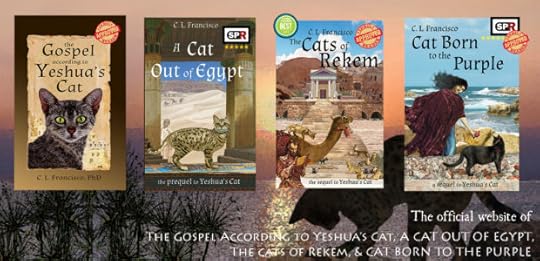
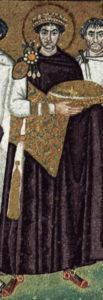
Emperor Justinian I in Royal Purple
I knew absolutely nothing about the roots of the phrase “born to the purple” when I began writing Purple. Neither had I ever heard of the Murex trunculus, a predatory sea snail found along many Mediterranean coasts, from which the royal purple dye was extracted. Even more humbling was my discovery that I understood nothing whatever about how cloth is spun and woven–now, or in the 1st Century CE. Oh, I knew the words and how to use them in sentences: warp and weft, loom and shuttle, spindle and bobbin . . . but I soon realized that I didn’t have a clue what any of those objects actually did in the process of transforming raw material–wool in particular–into cloth.
Textile manufacture was one of a very few areas where a women might succeed in business in New Testament times. The reference in Acts 16:14, to “Lydia, a dealer in purple fabric,” was one obvious instance. And if I did decide to write about a woman skilled in weaving, I needed to understand what was involved in that skill. So I checked out every book I could find in local public libraries about weaving wool, from raising the sheep to selling the finished textiles–and I hardly understood a word. Every book, no matter how simple, either assumed I already knew what weaving terms meant, or explained the meanings so superficially that they might as well have been speaking a foreign language–which is what the specialist terms of any discipline are to outsiders.
I tried websites, and YouTube, and eventually went to the library at Bard College where I finally discovered THE reigning expert in ancient textile studies–who understood the necessity of defining every single term before starting to use it, no matter how obvious it might seem to her. Her name is Elizabeth Wayland Barber, and she is the author of a highly entertaining and groundbreaking scholarly survey called Prehistoric Textiles (1991), and a more popular adaptation, entitled Women’s Work: The first 20,000 years (1994). I could never have written the book without her!
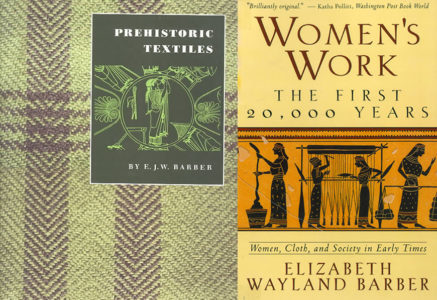
So, as a gesture of appreciation to her for her blessed clarity and thoroughness, I will try to explain the basics of early 1st C wool manufacture in Israel. I speak of wool particularly, because Murex dye only stains animal fiber successfully, and only wool absorbs the color thoroughly enough to create the deep blackish red-violet hue that royalty prized.
Sheep were raised in hilly and mountainous areas throughout the Ancient Near East. In most instances they were sheared and the wool cleaned and processed wherever the sheep were raised. Often a cottage industry grew up among local women for the spinning of the thread, so that urban weavers never worked with the fleece at all. But I’ve already begun to use words without defining them, so I’ll pause and look more closely at this first stage.
Preparing the fleece
By the 1st C, sheep had been selectively bred for thick, long fleece of various colors. Each spring the sheep were sheared with large iron shears. In the eastern Mediterranean, the first task after shearing was removing the larger problem areas from the fleece: dung tags, short, poor quality wool, matted wool, hardened grease. The fleece was then laid out on a rack and beaten with flexible rods to remove dust and seeds.

unwashed & washed fleece
Then the fleece was washed with some sort of solvent, in order to remove the grease–otherwise dye would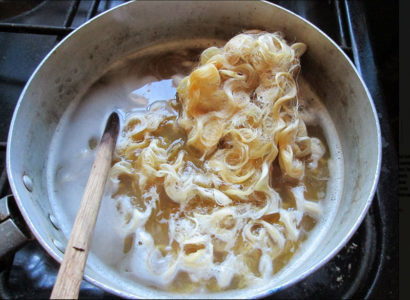 not take. Roughly twenty gallons of hot liquid was needed to wash two whole fleeces. In Israel, typically 3 parts hot water and 1 part urine were combined for the wash. The wool pelts were carefully teased apart and gently submerged in the washing vat, where they remained overnight. The washers took extreme care not to stir the wool in the bath, especially when the water was still hot, since that could cause it to “felt”, or stick together in a mat that couldn’t be spun or woven, although lesser quality wool was often “felted” intentionally. After soaking, the wool was carefully and thoroughly rinsed. In Israel the washed wool was either spread over bushes or put into light bags, swung around in circles, and then spread out to dry.
not take. Roughly twenty gallons of hot liquid was needed to wash two whole fleeces. In Israel, typically 3 parts hot water and 1 part urine were combined for the wash. The wool pelts were carefully teased apart and gently submerged in the washing vat, where they remained overnight. The washers took extreme care not to stir the wool in the bath, especially when the water was still hot, since that could cause it to “felt”, or stick together in a mat that couldn’t be spun or woven, although lesser quality wool was often “felted” intentionally. After soaking, the wool was carefully and thoroughly rinsed. In Israel the washed wool was either spread over bushes or put into light bags, swung around in circles, and then spread out to dry.

Neolithic “card” for flax
Once the fleece dried, it was gently pulled apart into separate strands, and shaken to remove any remaining seeds. By the 1st C, the different lengths of wool fibers weren’t separated unless the women doing the spinning intended to make the hard strong thread called worsted, which required long fibers laid out straight alongside each other. “Carding” was the most common method of preparing fleece for spinning by the 1st C. It involved lightly brushing or fluffing the wool fibers between two “cards” with protruding teeth–a bit like teasing hair. It resulted in a mass of fluffy fiber, evenly combed and separated, that could be pulled out in a steady thin stream for spinning.
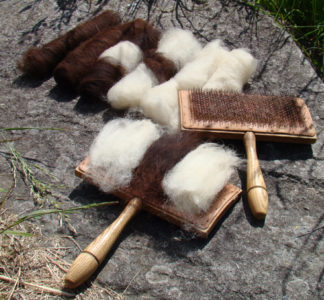
Modern wool carders & fleece ready to spin
Spinning
Ancient ingenuity gradually produced simple tools to make the intensely frustrating process of early spinning relatively easy. Barber put it something like this. Hand-spinning involved 3 processes–thinning and lengthening, twisting, and winding the thread onto a holder. But to do this, a woman really needed 4 hands:
1 hand to hold the prepared fluff of wool fibers
1 hand to pull thinned fibers out of the fluff and attach them to the emerging thread
1 hand to keep twisting the thread
and 1 hand to hold finished thread, lest it ball up like angry rubber band
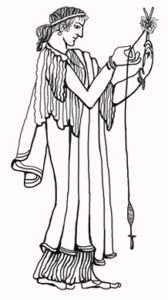
Greek woman spinning, 500 BCE
The distaff (“fuzz-stick”) was developed to hold a large mass of prepared fuzzy fleece; often it was no more than a forked stick held by the weaver. She pulled a steady stream of fuzz off the distaff, attaching it to the emerging thread. The “spindle” solved two problems at one time: how to twist the emerging length of fluff, and how to anchor the spun thread so that it wouldn’t recoil on itself. A spindle is basically a smooth stick of wood about a foot long, with a hook or groove for attaching thread, and a “whorl,” a roughly cylindrical object with a centered hole, attached to the shaft of the spindle, to reduce wobble. The thread is attached to the spindle, the spindle is set spinning, dropped, and spins the thread on its own like a top as the spinner uses her 2nd hand to pull and secure the fibers. When the spindle slows and stops, the spinner winds the accumulated thread around the spindle and sets it spinning again. Skilled spinners hardly pause at all between one spin and the next, and maneuver the spindle to wind the finished thread almost without guidance.
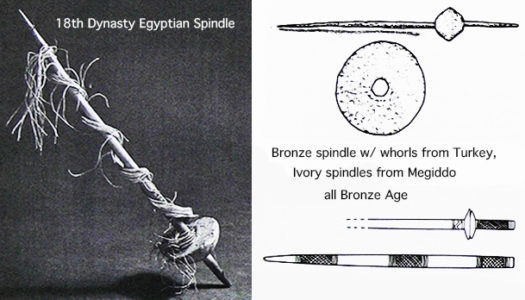
The last step in spinning is “plying.” When the twisted thread is removed from the spindle if it is not “plied,” it will simply unravel. So 2 threads are twisted together in the opposite direction to their original spin (plied), resulting in a length of thread that is not only twice as thick, but doesn’t unravel, either.
Weaving
From about the year 2000 BCE until the time of Christ, women in Palestine did most of their weaving on warp-weighted looms–vertical looms that leaned against walls. Women stood to weave and the finished cloth accumulated at the top. They were called by this name because the warp threads–the strong vertical threads through which the woof or weft threads were woven, were held in place by weights attached at the bottom. The famous Greek urn from around 600 BCE shows one such loom (below). Several threads secured on the top beam are weighed down together in straight lines by clay, stone or other types of weights at the bottom. The woman on the left is beating, or pushing, the most recent weft threads up tightly into the finished cloth rolled onto the top beam. The woman on the right is weaving the horizontal weft thread between the vertical warp threads.
The size of the loom depended partly on the type of fiber being woven. Estimates based on loom weights and fragments of cloth suggest that the width of woven wool varied between 33-78 cm. Light fibers like linen and hemp were often wider.
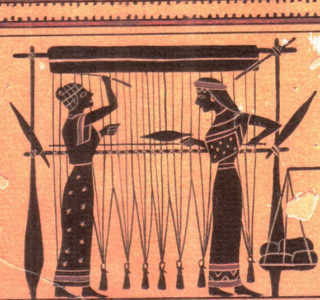
Here are some basic weaving terms:
Loom = frame holding thread for weaving
Loom weights = stones, etc., attached to bottom of warp threads/groups of threads
Warp = the vertical weighted threads
Weft (old past tense of weave) = horizontal threads added in between warp threads
Plain weave = one thread of warp over/under one of weft, etc. This was the simplest weave, still seen today in sheets and pillowcases. Pattern was added by taking the weft over and under different numbers of warp threads
Starting border = a narrow woven band attached to upper beam to keep warp threads separate and spaced evenly
Heddle rod = movable rod that leans against front of loom, either resting against loom itself, or lifted up and away and resting on supports.
Heddles = small loops w/strings attached to the heddle rod, through which alternating warp threads pass (1 string/group of strings thru each heddle). Heddle loops are each tied to the heddle rod. When the heddle rod is lifted up onto its supports, it creates a gap (shed) between warp threads attached to it (and now raised) and the warp threads below not attached to heddles.
Shed rod = moveable rod at base of loom above loom weights over which the alternate warp threads not tied to heddles are hung. When heddle rod is lowered from its supports, the shed rod holds its threads above the others (the lower threads above the heddle threads), creating a second shed through which to pass a weft thread.
Shed = the gap between alternating layers of warp threads through which weft is pulled. The whole line of weft is passed through this passageway/gap with a shuttle
A drawing from Barber’s Prehistoric Textiles (below) may help these terms make sense. This drawing probably shows a simple kind of warp-weighted loom probably found in Palestinian homes in the early 1st C CE (I used her drawing as the model for the one in Purple):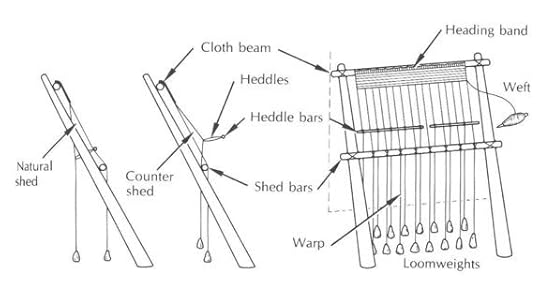
So here’s the process, vastly simplified:
Tie the warp threads to top of loom, draping all warp threads over frame
Attach starting border to upper beam, woven of cord, to keep warp cords evenly spaced and not crowded
Thread alternate warp threads into consecutive heddle loops attached to heddle rod toward top of loom, letting ends hang down toward floor
The lower (unattached to heddles) warp threads remain over shed rod at bottom, so that they hang straight from woven fabric at top to rod at base
Attach weights to all warp threads/groups by small cords
Lift heddle rod up on to supports to create shed between lower warp and heddled warp threads
Send weft through the shed
Beat up toward top tightly
Lower heddle rod from supports to loom frame; the heddled warp threads will hang below loom frame from heddles, toward floor
Alternate warp threads draped over shed rod will now be higher, creating a shed between lower and upper warp threads
Send weft through 2nd shed, beat up, and repeat.
Finished cloth rolled up on top beam

Double-beam Loom
Then sometime in the mid-to-late 1st C CE all this changed with the introduction of the upright two-beam loom, developed somewhere in the Levant and/or Syria and spread by the Romans throughout the rest of the empire. The weights were replaced by a second horizontal beam at the bottom, and the weaving went from top to bottom, which meant that the weaver could sit while weaving.
The main problem scholars have had in understanding early weaving techniques has been that neither looms nor textiles often survive over time, although the clay, stone, and bone tools often do. The sudden disappearance of loom weights from archaeological sites dating to the beginning of the 2nd century CE was the most obvious indication of this change in weaving technology.
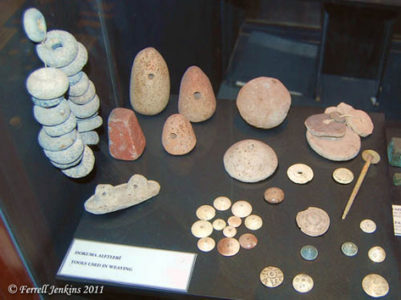
Weaving tools from ancient Gezer in Judea. Photo by Ferrel Jenkins. Most of the tools pictured are loom weights and spindle whorls.
One last interesting observation on cloth made in the first century is the time involved. A simple garment of a plain weave used approximately 1.5 x 5 meters of cloth. The spinning of the yarn alone took approximately 120 hours. Setting up the loom with the border and warp threads took about 50 hours, with another 50-60 hours for the weaving itself. By the time you added in the sewing and finishing, the total time invested in one simple garment would be over 250 hours!
.
October 14, 2016
IndieReader Gives Purple 5 Stars!
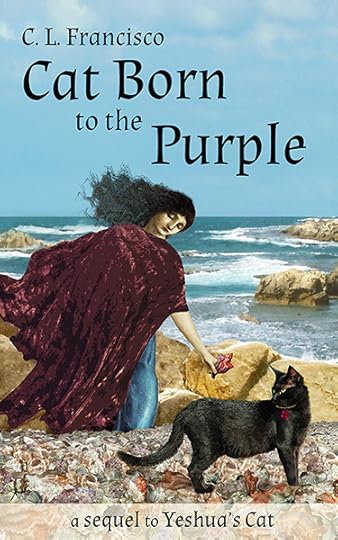
Purple gets its 2nd review: 5 stars!
Here’s an excerpt from IndieReader’s review:
“CAT BORN TO THE PURPLE is a poetic tale with a flair for description and a welcoming, hopeful, and loving spiritual heart. Textile work is a common thread (pun intended) through this novel, and everything from the cruelty of the murex-harvesting and dyeing process to the intricacy of the weaving patterns finds deeper meaning in the story and the theology . . . [The kitten named] Purple is an appealing narrator, with a recognizable-yet-alien felinoid point of view, that adds a valuable perspective to the novel . . . [Cat] is full of warmth and deep loving-kindness, and Francisco’s conception of Yeshua shines with the charisma and compassion that explain plausibly why people would willingly drop everything and follow him.”
IndieReader: 5 stars

Read the full review here, on the Purple Reviews page on the drop-down menu.
AND the Kindle version of Cat Born to the Purple is live NOW on Amazon
.

